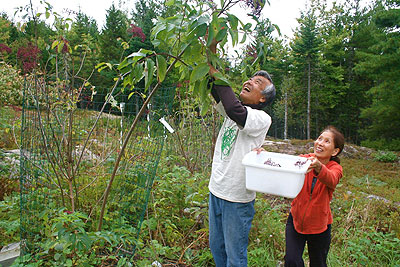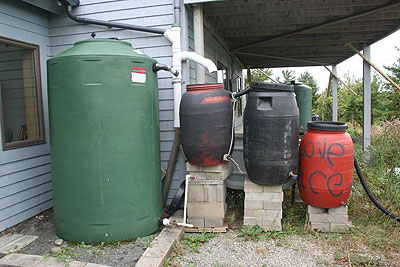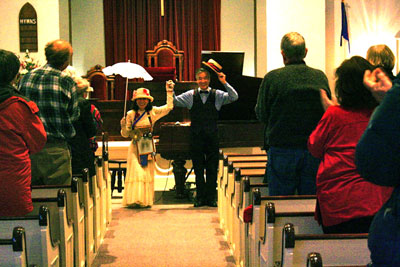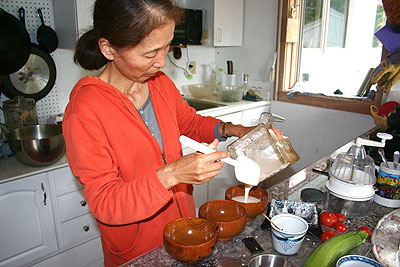 |
| Masanobu (left) and Tomoko Ikemiya cut elderberries at their Peace Farm in Bar Harbor. All photos by the author. |
By Laurie Schreiber
“Well, here we are! This is it!” Masanobu Ikemiya declares in greeting, and then sets out on a tour of Peace Farm, the self-sustaining homestead he’s built with his wife, Tomoko, in Bar Harbor, Maine.
Both are high-energy and cheerful. Masanobu is a take-charge guy. Dominating the narrative as Tomoko goes off with a basket to pick vegetables, he is delighted to show off low-maintenance technologies that help them grow almost all their own food for a diet of primarily raw and live foods, live off the grid, and maintain a life of harmony with the environment.
Masanobu is a concert pianist, conductor and recording artist, a foremost exponent of American ragtime, the founder of the Arcady Music Festival in Maine and of the New York Ragtime Orchestra, and a Zen Buddhist disciple.
Tomoko is a former nurse-midwife, psychologist and college instructor. She now manages her husband’s career.
Both are ardent about bringing a message of intercultural harmony and sustainable living to the world. In 2004, the couple left New York City to transform their Bar Harbor summer house into a year-round home. Carved from 3.5 acres of hillside woods and built up from granite ledge, the house and extensive gardens comprise a model for how to live comfortable, globally connected lives with as little environmental impact as possible.
 |
| Rain barrels collect water for the garden. |
A Garden of Permaculture and Alive Energy
On initial impression, their permaculture gardens appear chaotic. They don’t till the soil, as soil is alive, Ikemiya says, and tilling destroys the ecosystem. Weeds are considered part of the ecosystem, and their roots help rainwater seep into the soil.
“Let nature do the work,” he says. “The plants know better than we do how to grow.”
Constructing the gardens was “kind of haphazard,” he says.
“At the beginning, there was nothing, so I gradually kept building, gathering the leaves from the forest, building the topsoil, getting seaweed from the ocean.”
Rainwater collected from the roofs, using gutters and PVC pipes linked to cisterns, along with hillside runoff channeled to a vinyl-sided pit, irrigates the gardens. Drinking water comes from a well.
Produce abounds, from the usual garden plants – carrots, peppers, squash – to goodies such as Japanese plum trees, American chestnuts, juicy grapes on a rebar arbor, northern kiwi, lime trees, pawpaw, kabocha, daikon and red shiso.
Produce is canned, dried or stored in a naturally vented root cellar, the latter based on a design Ikemiya learned at the Common Ground Country Fair.
Compost bins feed to a cistern that collects nutrient-rich tea. Ikemiya stirs the dark brown brew.
“When you give this to the plant, they just go wild because it’s alive energy,” he says.
“Alive energy,” “life force” and “harmony” are some of Ikemiya’s favorite words. In his and Tomoko’s worldview, everything in the universe is connected. He is lucky and grateful, he frequently says, to have experienced life’s fortunes, and both want to help others who are less lucky.
Rising from Destruction
Their passion for taking care of the earth and its inhabitants is rooted in their youth, when World War II and its terrible aftermath in Japan gripped their families. As the Japanese struggled to recover, Ikemiya’s father, Masayuki, went to Manchuria, China, to serve as a Christian missionary. There, he married Tsuneko, also a missionary, and they started a family. But they found themselves trapped in the civil war between the Chinese Nationalist Party and the Communist Party.
“It was a tragic, chaotic situation,” Ikemiya says. “If they find out that you are Japanese, you get killed. If they find out you are Christian, that’s even worse.”
Masayuki and Tsuneko, with a toddler and baby, began a horrendous winter trek to the coast, where they hoped to get a boat to Japan.
“Below zero, freezing weather, whatever they can carry. My mother and father were on foot in the snow and sleet.”
Occasionally, they snuck onto a train.
“One story was that, because it was completely full, the only place my mother could stand was in front of the steam engine. When it was moving, she is next to the hot steam, and in the front is Siberia, below zero, snow blowing in her face. And she was carrying me. She couldn’t move. She was completely frozen.”
The family made it home. Masayuki completed his Ph.D. in biochemistry. In 1962, he was invited to teach at Kansas State. Young Masanobu became a star high school science student, then a top piano student, earning a master’s degree with distinction. But he dropped music and pursued an interest in Zen Buddhism at a monastery in Surry, Maine.
 |
| The Ikemiyas at a ragtime concert. |
Divine and Ragtime Music
A decade later, he rediscovered piano with the arrival at the zendo of flutist Claude Monteux, who invited Ikemiya to a musical session.
“I was just in heaven and, after we finished, I just couldn’t sleep,” Ikemiya recalls. “With his encouragement I decided to go back to music.”
In 1980, he founded the Arcady Music Festival, which soon attracted renown.
“We had these incredible, high-level musicians, just sparkle-divine, landed in the same place here in Maine,” says Ikemiya.
Setting up a winter home in New York City, his musical interests took a curious tangent when he was volunteering at a homeless shelter. A piano sat in one corner; Ikemiya tried to connect with troubled youth through classical music. It didn’t work.
One day, an old man walked in, sat at the piano, and pounded out some joyful tunes. Ikemiya had never heard anything like it.
“He just started pounding like a mad man, and all the kids went next to him. ‘Oh, wow, this is fun!’”
The sound was ragtime, and Ikemiya took to the form with his usual exuberance. He founded the New York Ragtime Orchestra; ever since, classical and ragtime have held equal standing in his repertoire.
“I travel all over the world giving concerts and, every time I play ragtime, it brings smiles to the people,” he says. “I can’t talk to them with their language, but with the music, everybody’s smiling, they’re clapping hands.”
Ikemiya’s honors include a United Nations award for “Promoting World Peace” and a certificate from the Kurgan (Siberia) Philharmonic Orchestra for his efforts to promote friendship between the Soviet and American people. His concert tours take him around the world. In Japan and the United States, he performs regularly with major orchestras and has appeared solo at New York’s Lincoln Center, the Smithsonian Institution in Washington, D.C., and other venues.
His programs always include presentations on various causes – such as a slide show on sustainable farming, and on the 2011 tsunami and nuclear disaster in Japan. The couple are passionate community volunteers at a local homeless shelter and other service organizations; they stage benefit concerts and donate produce to food banks. They seek to nurture empathy among people around the world.
Another Tragedy, Another Move
The decision to pursue the back-to-the-land lifestyle, with its self-sufficient, do-no-harm practices, came with the tragedy of Sept. 11, 2001. At the time, the Ikemiyas were in New York.
“We didn’t actually know what happened,” he says. “Tomoko’s sister called from Japan. ‘Are you okay?’ It was midmorning. So we turned on the TV.”
By 2004, they were ready to live in Maine year-round. Today, their ideas have blossomed. In addition to raising and storing food, conserving water and collecting humanure from a composting toilet, they’ve maximized household energy efficiency through woodstove and solar heating. The house is warm, sunny and modern; the homestead conforms with the couple’s needs as they tour the world’s performance stages.
Upstairs, Ikemiya’s cathedral-ceiling studio overlooks the gardens. The room, designed with acoustics in mind, is equipped with a bright-sounding spinet for ragtime and two Steinway grands, one a perfectly kept, 1875 square style rarely seen today.
 |
| Tomoko pours raw corn chowder made from corn and garlic from the garden, water, raw cashews, walnuts, sunflower seeds, Maine sea salt and cayenne. |
Raw, Living Foods
In the kitchen, the couple is getting ready to demonstrate some raw- and live-food recipes. Ikemiya pulls out Gabrielle Chavez’s book The Raw Food Gourmet, which explains that the raw and living foods lifestyle supports overall health and healing, provides more energy, avoids chemicals added and nutrients lost, and fosters harmony, peace and appreciation for one’s own body, mind and spirit, for animals and plants, and for the earth.
Eating raw and living food “is like eating the essence of life,” he says.
“And it’s very economical,” says Tomoko.
“Raw food” is self-explanatory. Examples of live foods are yogurt and sprouted seeds.
Masanobu pours a tasty sun tea from a jar he had prepared earlier in the day. The batch is stuffed with rose petal, calendula flower, anise hyssop, mint lemon balm, nettle, lavender and holy basil.
“We never know how it tastes, because I just throw in whatever. But it doesn’t matter, anything that’s in season,” he says. “What I like about this is that, somehow, it makes our minds clear. And stable energy, rather than coffee, just bwaaaah!” He mimics hyperactivity, then mock-slumps. “And then you’re down. But this is just steady and natural. You’re clear and feel alive and grateful that you’re living on planet earth.”
For a raw corn chowder, Tomoko cuts kernels off a cob, tosses them in the blender, adds a cup of water, a clove of garlic, half a cup of raw cashews, a quarter-cup each of walnuts and sunflower seeds, and a dash of Maine sea salt and cayenne. The seeds have been soaked for about an hour, and “they come back alive,” says Masanobu. Seeds, nuts, grains and dairy come from local shops and farms.
“When you do raw foods, you don’t need pots and pans, but you need a really good blender and food processor,” Tomoko says.
The vegetable world provides all the protein a person needs, says Masanobu, who was declared by one doctor “the healthiest person” he had ever examined.
The chowder is delicious – the corn sweet, the garlic piquant.
Masanobu dishes up kimchi, a pickled vegetable mix, made earlier in the week and now slightly fermented.
“It’s really simple,” he says. “I put all kinds of things in it – garlic, ginger, napa, cucumber, nettle, daikon, other things. I just picked out of the garden.”
A little salt breaks down the fibers and draws out the juices as he massages or pounds the mix. We spoon the mixture onto slices of squash that came from the dehydrator. The kimchi tastes pleasurably of garlic and ginger. The squash slices have a pleasing, cracker-like crunch.
“People always say, ‘Gosh, what do you eat!? You don’t cook anything!’” Masanobu says. “People are so used to meat and potato and having everything cooked. I say, ‘We don’t have to.’”
Outside, a breeze whispers in the woods. Soon, the couple will get their produce in. They will travel, perform, volunteer, and continue to share their message of harmony.
“I don’t want to think, just because I came to the earth to live, I ended up destroying, consuming all these things, and left, making a mess out of it,” Ikemiya says. “I want to leave as little footprint as possible. That goes to the teaching of don’t harm other living beings. The commandment says, Thou shall not kill. Most people think it means other people. I think it means all living beings.”
About the author: Laurie Schreiber is a freelance writer who lives in Bass Harbor.
